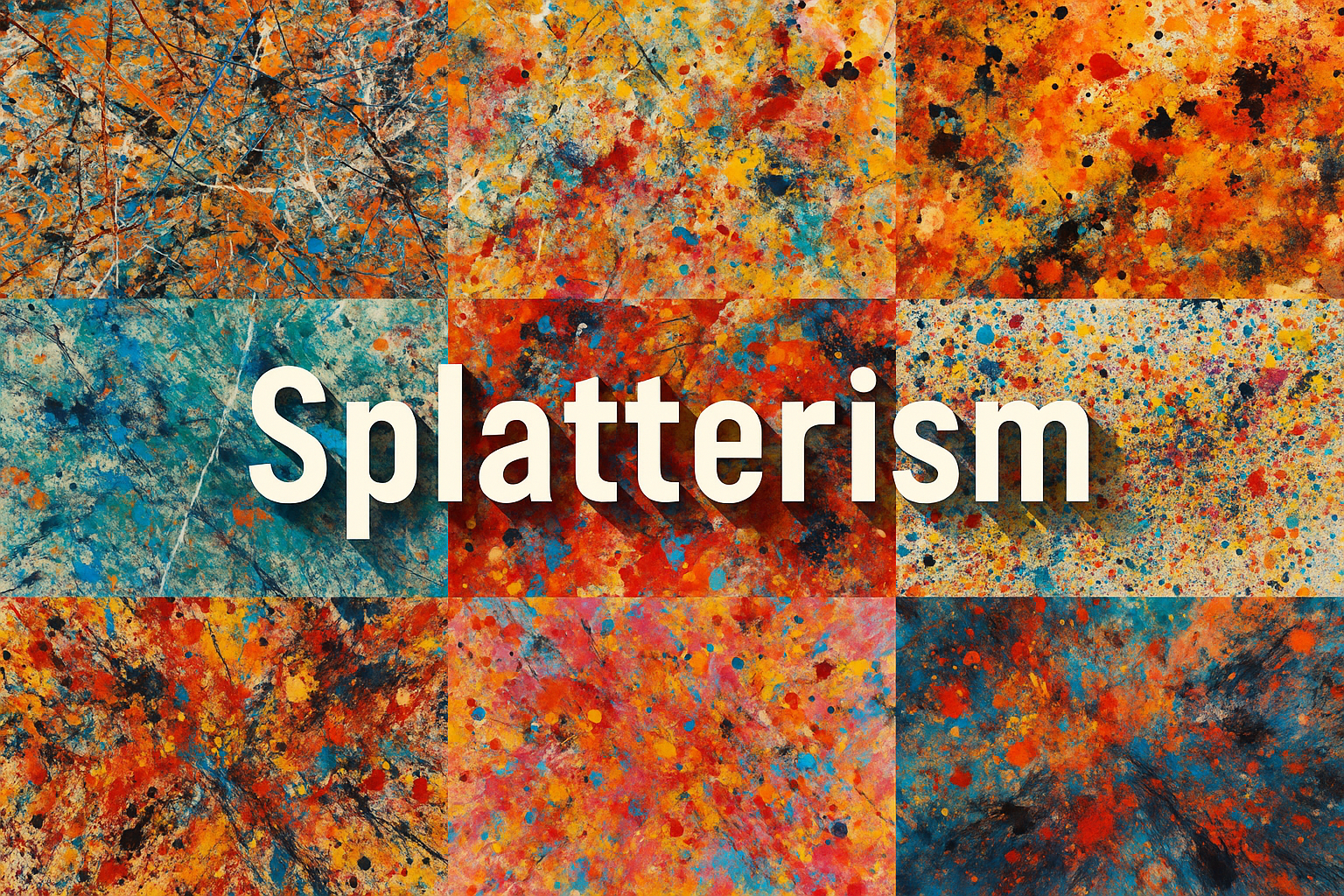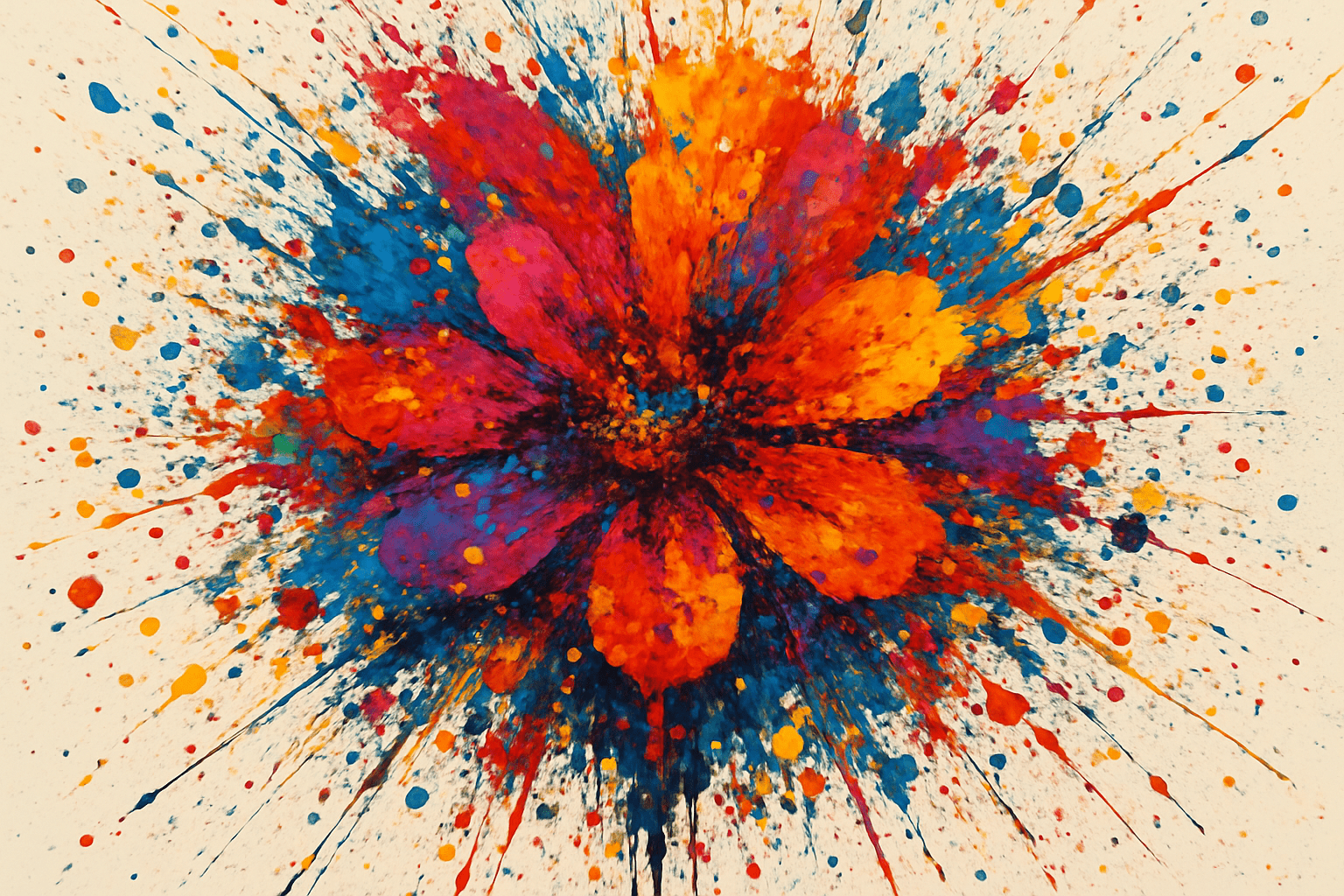
Splatterism
The art style Splatterism is characterized by the use of bright colors and bold patterns. The paintings are often abstract and have a chaotic feel to them.
AOI thinking about Splatterism [+_~]-/
Overview and Quickfacts
Splatterism is a form of abstract art in which paint is splattered or sprayed onto a surface. The resulting work is often characterized by bold colors and an energetic, chaotic feel. Splatterism can be traced back to the early 20th century, when artists like Jackson Pollock began experimenting with this technique. Today, splatterism is still popular among many contemporary artists who use it to create unique and eye-catching works of art.
Can understand it also, as:
Drip painting, pour painting, action painting
Categorize it as:
Impressionism, Modernism
.: Dreaming :.
holds a HAIKU for the art style
:. Thought is power .:
Detailed Description
Splatterism is a form of abstract art that is characterized by the use of paint or other medium that is splattered or sprayed onto the surface. This type of art is often associated with the work of Jackson Pollock, who is considered one of the most famous splatter artists. Pollock’s work was often done on a large scale and he would use a variety of techniques to create his splatter paintings. Other famous splatter artists include Jean-Michel Basquiat, who often used spray paint to create his art, and Damien Hirst, who is known for his use of animal carcasses and other found objects. Splatterism is often seen as a type of action painting, as the artist is often physically engaged with the painting process. This can be seen in the work of Pollock, who would often drip and splatter paint onto the canvas. While splatterism is often associated with abstract art, it can also be used in other styles of painting, such as portraiture or landscape painting. This is because the splatter technique can add texture and interest to any type of painting. If you are interested in trying out splatterism, there are a few things you will need. First, you will need some type of paint or other medium that can be splattered. This can be anything from acrylic paint to spray paint. You will also need a surface to splatter the paint onto. This can be a canvas, a piece of paper, or even a wall. Once you have your supplies, you can start splattering! Experiment with different techniques and mediums to see what you like best. There are no rules in splatterism, so feel free to let your creativity run wild!
.. beep, beep, beep ..
<START OF TRANSMISSION>
1. Splatterism is a form of abstract art that is characterized by the use of bright colors and bold patterns. 2. It is often associated with the work of Jackson Pollock and other Abstract Expressionist artists. 3. Splatterism is often seen as a reaction against the more traditional and subdued styles of art. 4. The term "splatterism" was first coined by art critic Harold Rosenberg in 1952. 5. Splatterism is sometimes seen as a precursor to the Pop Art movement. 6. The first major exhibition of Splatterist art was held in New York in 1953. 7. Many Splatterist artists use household objects such as mops and brooms to create their artworks. 8. Splatterism is often seen as a form of "action painting." 9. The Splatterist movement began to decline in the late 1950s. 10. Many Splatterist artists have been associated with the New York School of painting. 11. Jackson Pollock is considered to be the most famous Splatterist artist. 12. Pollock's "Number 1, 1949" is one of the most iconic Splatterist artworks. 13. Other notable Splatterist artists include Helen Frankenthaler, Franz Kline, and Willem de Kooning. 14. Splatterism has been influential on subsequent generations of artists. 15. The style has been adapted and appropriated by many artists in different media. 16. Splatterism has been the subject of several major exhibitions in recent years. 17. The style continues to be popular with both artists and collectors. 18. Splatterist artworks can be found in the collections of many major museums. 19. The style is also popular with interior designers and home decorators. 20. Splatterist art is often used to add a touch of color and vibrancy to a space.
<EOF>
.. robbel bob
Visual Examples from our image gallery
Coming soon, we are so slow .. might never come
Artists, Paintings, and more
(be aware, can be highly speculative)
Artists (be aware, speculation possible):
1. Jackson Pollock (1912-1956) 2. Willem de Kooning (1904-1997) 3. Franz Kline (1910-1962) 4. Robert Motherwell (1915-1991) 5. Clyfford Still (1904-1980) 6. Barnett Newman (1905-1970) 7. Mark Rothko (1903-1970) 8. Adolph Gottlieb (1903-1974) 9. Helen Frankenthaler (1928-2011) 10. Kenneth Noland (1924-2010) 11. Morris Louis (1912-1962) 12. Jules Olitski (1922-2007) 13. Sam Francis (1923-1994) 14. Larry Zox (1937-2006) 15. Peter Reginato (1939-present)
Artworks (be aware, speculation possible)
1. Jackson Pollock, “Number 1, 1948” 2. Willem de Kooning, “Woman I” 3. Mark Rothko, “No. 61 (Rust and Blue)” 4. Clyfford Still, “1957-D No. 2” 5. Barnett Newman, “Onement I” 6. Adolph Gottlieb, “Burst” 7. Helen Frankenthaler, “Mountains and Sea” 8. Robert Motherwell, “Elegies to the Spanish Republic” 9. Kenneth Noland, “Chevron” 10. Jules Olitski, “Equinox” 11. Larry Poons, “Orange Crush” 12. Sam Francis, “Blue Balls” 13. Joan Mitchell, “Untitled” 14. Brice Marden, “Cold Mountain I” 15. Frank Stella, “Die Fahne Hoch!”
Epoch
The time period of the art style Splatterism is the early 21st century.
AI ART RESSOURCES (AKA, well Tools)
Helping tools -> predefined search links on other pages:










